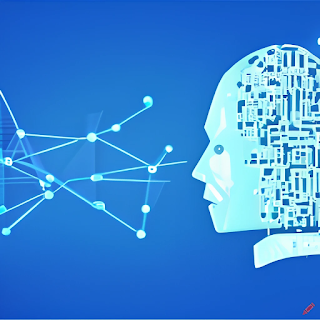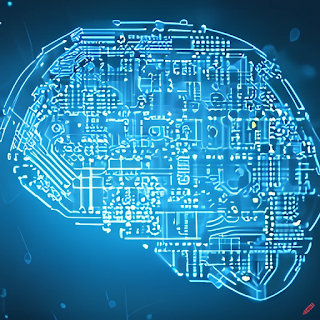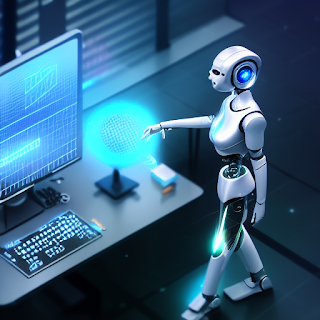Artificial intelligence (AI) vs. machine learning (ML)
 |
| Artificial intelligence (AI) vs. machine learning (ML) |
 |
| Artificial intelligence (AI) vs. machine learning (ML) |
 |
| Artificial intelligence (AI) vs. machine learning (ML) |
Are you confused about the
difference between Artificial Intelligence (AI) and Machine Learning (ML)?
You're not alone! AI and ML are two of the most talked-about topics in
technology today, but it can be hard to understand what sets them apart. Let's
take a closer look at how these two powerful tools work together. AI and ML are
both types of technology that enable computers to make decisions or take
actions without direct programming. AI uses data-driven algorithms to solve
complex problems, while ML uses algorithms to train computers to find patterns
in data and improve performance over time. AI can be used to make predictions
based on a set of given parameters. For example, AI is often used to predict
the stock market or weather forecasts. On the other hand, ML allows machines to
learn from experience and improve their decision making with minimal human intervention.
This means that ML systems are able to process large amounts of data quickly
and accurately identify patterns or trends which may not have been noticeable
before.
In conclusion, AI and ML are two
powerful technologies that are changing how we interact with computers and the
world around us. Both technologies offer tremendous potential to improve our
lives, but it's important to remember that they are still evolving and we
should approach them thoughtfully in order to maximize their potential benefits.
Artificial intelligence (AI) and machine learning (ML) are two technologies
that have been making waves in the world of computing. While both have
tremendous potential to revolutionize our lives, they often get confused with
each other as they share some similarities. It’s important to understand the
differences between AI and ML so that you can make informed decisions when
deciding which technology is right for your project.
At their core, AI and ML are both
about using computers to solve problems without direct programming from humans.
AI works by inputting data into algorithms that enable the computer to process
it and draw conclusions or take actions accordingly. This means that AI can be
used to solve complex problems based on certain parameters that were programmed
into it.
Exploring
AI and ML Benefits
Artificial intelligence (AI) and
machine learning (ML) are two of the most powerful technologies available
today. AI is a broad term that refers to machines that can think, learn, and
act like humans. ML is a subset of AI that focuses on teaching computers how to
make decisions based on data. Both have tremendous potential to revolutionize
industries and improve our lives.
The benefits of AI and ML are vast.
For example, they can help automate tedious tasks, such as sorting through
large amounts of data or recognizing patterns in images. They can also be used
to create more efficient processes, such as predicting customer needs or
optimizing supply chains. Additionally, these technologies can provide insights
into complex problems, such as diagnosing diseases or detecting fraud.
 |
|
On a broader level, AI and ML can
help us tackle global issues such as climate change or food insecurity. For
instance, AI-powered systems can be used to monitor the environment and
identify patterns that may indicate an impending natural disaster. Likewise, ML
can be used to accurately predict future crop yields and detect subtle changes
in water quality. The possibilities of AI and ML are nearly endless, and the
potential benefits for society are enormous.
AI and ML are increasingly becoming
integral parts of everyday life. From self-driving cars to smart home
assistants, these technologies are already transforming how we interact with
the world around us. With each passing day, AI and ML become even more
sophisticated and powerful. It’s an exciting time for technology, and these two
technologies have the potential to revolutionize our lives in incredible ways.
However, what is the difference
between AI and ML? Artificial intelligence (AI) is a broad term that refers to
any system that can “think” on its own. AI systems are designed to solve
complex problems or make decisions based on given information. On the other
hand, machine learning (ML) is a subset of AI focused specifically on
algorithms that “learn” from data provided to them.
A key distinction between AI and ML is that with AI,
you do not need as much data input. In other words, AI systems can use existing
patterns in order to identify solutions and make decisions without needing to
have a huge amount of data. This makes AI great for solving problems quickly.
ML, on the other hand, needs large amounts of data in order to learn and make
accurate predictions or decisions. As such, it is better suited for tasks that
require more precision or accuracy.
AI and ML are both powerful tools that can be used to
solve complex problems and revolutionize how we interact with the world around
us. While they share some similarities, they each offer unique advantages
depending on at its core, AI is a type of computer system that can “think”
independently. It uses existing patterns or information in order to identify
solutions and make decisions without needing human input. Machine learning
(ML), on the other hand, refers to algorithms that “learn” from data provided
to them.
How are AI and ML connected?
AI is a broad term that refers to any technology that
can think or act like a human. Machine learning is a subset of AI that focuses
on using algorithms to learn from data and make predictions.
In other words, AI is the umbrella under which machine
learning falls. AI is used to create intelligent machines that can understand
their environment and take actions based on what they learn. Machine learning
takes this one step further by allowing these machines to use data to improve
their performance over time.
 |
AI and ML connected |
For example, an AI-powered robot might be able to recognize objects in its environment and respond accordingly. With machine learning, it could then use data about those objects to make better decisions and even anticipate future events. This data could come from its own experience or from external sources such as sensors.
The key difference between AI and machine learning is
that while AI involves programming machines to think like humans, ML involves
creating algorithms that can learn from data and make decisions without human
input. By leveraging the power of both technologies, it's possible to create
powerful systems that are able to analyze vast amounts of data, identify
patterns and trends, and act upon them in order to improve performance over
time.
In conclusion, AI and machine learning are closely related but have distinct differences. AI provides a framework for developing intelligent systems that can reason, plan and take actions autonomously, while ML focuses on using data to create models and make predictions. As technology continues to evolve, the possibilities of AI and ML are sure to expand exponentially in the coming years. Both technologies have huge potentials when it comes to unlocking new insights and enhancing processes, making them essential tools for any business looking to stay ahead of the competition.


.jpeg)
